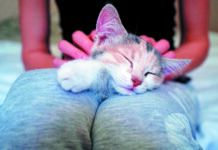In a recent study regarding the evolution of domesticated cats, DNA analysis suggests to researchers that the animals lived for thousands of years alongside humans before they were “domesticated.” And during that time, their genes have changed precious little from those of wildcats — with the exception of developing the unique stripes and spots of the tabby.
Evaluating the DNA of cats spanning the last 9,000 years — including ancient Roman cat remains, Egyptian cat mummies and modern African wildcat specimens — researchers believe that two major cat lineages contributed to our domestic feline. Their findings were recently published in Nature Ecology & Evolution.
The earlier ancestors of our domestic cats spread from southwest Asia and into Europe as early as 4400 B.C. It is believed that the cats started hanging around farming communities, where they settled into a mutually beneficial relationship as rodent patrol for farmers. Mice and rats were attracted to crops, and cats likely followed the rodent populations. In turn, both frequently approached the human settlements.
“This is probably how the first encounter between humans and cats occurred,” explains study coauthor Claudio Ottoni of the University of Leuven. “It’s not that humans took some cats and put them inside cages.” Instead, people more or less inadvertently allowed cats to domesticate themselves.
A second lineage — consisting of African cats that dominated Egypt — probably had behaviors that made it more attractive to humans, such as sociability and tameness. The results suggest that prehistoric human populations probably began bringing their cats along ancient land and sea trade routes to control rodents.
Surprisingly, wild and domestic cats showed no major differences in their genetic makeup, and one of the few traits that differentiated them was the tabby coat marking.
According to the study, the gene for a tabby coat dates back to the Ottoman Empire in Southwest Asia and later became common in Europe and Africa. It was only in the 18th century, however, that the markings became common enough to be associated with domestic cats. And in the 19th century, cat fanciers began selecting cats with particular traits to create fancy breeds.
Overall, cats became a domesticated companion of humans without changing much, says evolutionary geneticist and article coauthor Eva-Maria Geigl. Domestic cats may look similar to wildcats, but they aren’t solitary, and they are willing to tolerate both humans and other cats.
This is in contrast to dogs, which are the first animals to be domesticated, says Geigl. Dogs were selected to perform specific tasks — which never was the case for cats — and this selection for particular traits is what led to the diversification of dogs and the many breeds we see today. “I think that there was no need to subject cats to such a selection process since it was not necessary to change them,” Geigl says. “They were perfect as they were.”
Though this notion of “perfection” may not pass muster with dog lovers, cats still remain the most popular pets in the world — with as many as 74 million living in U.S. homes today.



